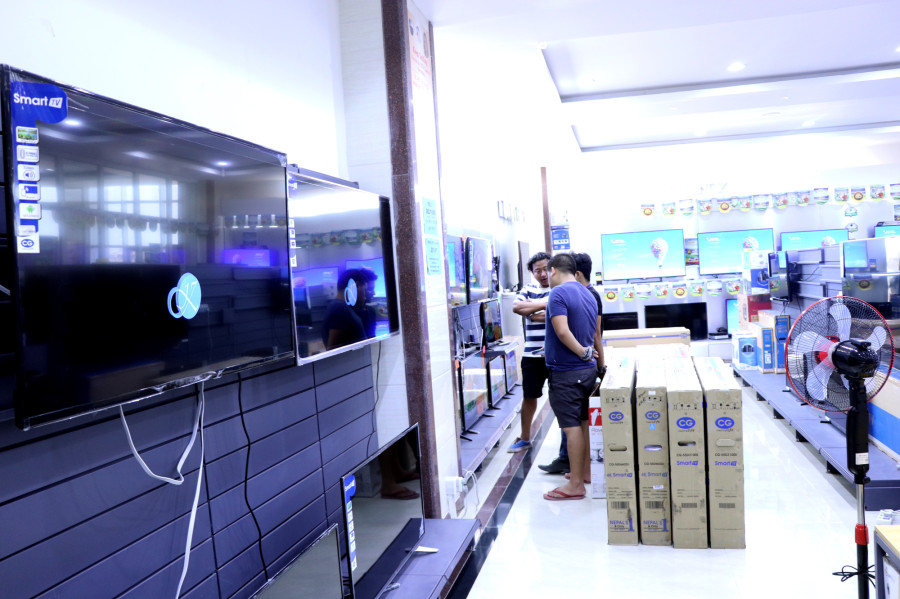Money
Surging coronavirus caseloads dampen New Year sales
A lacklustre customer mood has prevented many companies from launching bumper offers, schemes and discounts.
Krishana Prasain
Megha Khadka of Baneshwor was going to celebrate Nepali New Year's Day on Wednesday with her friends, but she suddenly got cold feet after hearing that the second wave of the Covid-19 pandemic was sweeping through the country.
“We had planned to have fun with family and close friends by having dinner or going somewhere. But the situation is not looking good,” the 36-year-old housing company employee told the Post. “We are not buying goods and clothes either.”
Like Khadka, the second wave of the virus has distressed many Nepalis across the country.
A lacklustre customer mood has prevented many companies from launching New Year bumper offers, schemes and discounts. Covid-19 has dampened New Year celebrations this year too after the fiasco last year, dealing a severe blow to consumption patterns—a major economic indicator.
After the Dashain and Tihar shopping seasons, consumers wait for the Nepali New Year market to buy goods ranging from automobiles to consumer electronics and food products, resulting in jam-packed supermarkets and shopping malls.
Traders said that disruptions in the supply of raw materials were already becoming apparent due to a jump in Covid-19 caseloads in neighbouring India.
The southern neighbour is Nepal’s largest trading partner, accounting for 61 percent of its total foreign trade. Nepal imported Rs735.3 billion worth of goods from India in the last fiscal year.
On Tuesday, India reported 161,736 new coronavirus cases. On the same day in Nepal, five Covid-19 related fatalities and 460 new cases were reported. A week ago on April 6, the daily tally reached 260 coronavirus infections.
Bishnu Gyawali, assistant general manager at CG Electronics, said that sales of consumer electronics had evaporated amid second wave fears. “There are no sales. Only a few customers with a great need are coming to buy electronic goods,” he said.
“We have a bevy of New Year schemes, but no one seems to be interested in shopping,” Gyawali told the Post. Higher prices have also kept sales down, he added.
According to electronics dealers, prices have increased by up to 30 percent in the local market due to dearer raw materials like TV panels, copper, aluminium and steel and a jump in freight charges in the global market.
Along with electronic items, sales of food items and clothing have also declined.
“New Year sales have dropped by 25 percent compared to previous years,'' said Sabindra Byanjankar, sales manager at Bhat Bhateni Supermarket, Tripureshwor. "Despite the various offerings and schemes, footfall has not gone up," he said.
“Besides the second wave of Covid-19, I feel that consumers are holding back on spending because of the virus uncertainty,” Byanjankar said. "There is no panic buying as one would expect following reports of a surge in the caseload."
Amid the general gloom in the market, automobile sales are up, however.
As per Ramesh Danekhu, marketing communications manager at Morang Auto Works, the authorised distributor of Yamaha and Skoda, car sales have not been impacted by the second wave; in fact, dealers are not able to meet demand due to slowed shipments from India.
“As Indian passenger vehicle manufacturers have slashed production, domestic automobile dealers are facing an inventory shortage,” he told the Post.
Danekhu said that demand for two-wheelers, which started climbing after the lockdown, was still robust. "Production has been impacted due to the second wave of the pandemic in India," he said.
According to automobile dealers, the price of four-wheelers in the domestic market has increased by Rs200,000 to Rs1 million per unit, depending on the brand and vehicle, after the lockdown following a global shortage of chips and a hike in steel prices.
Mobile phone sales have not seen any notable ups or downs.
"Supply in the domestic market has been hit as production has slowed due to a global shortage of chips," said Sanjay Agrawal, vice-president of the Mobile Phone Importers’ Association.
“The price of mobile phones has increased by 10-15 percent after the lockdown was lifted. Sales are normal and not as they used to be during the first phase of Covid-19 pandemic with most people already owning a set."




 7.12°C Kathmandu
7.12°C Kathmandu














